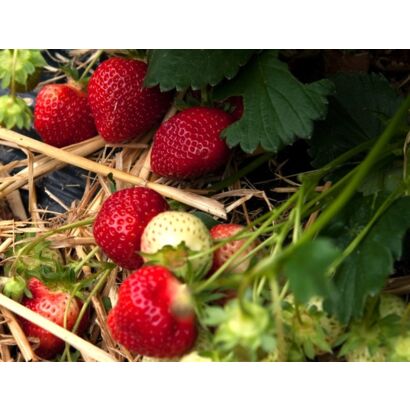Strawberry saplings Ruby de Jardins (Rubis des jardins)
Species: non-repairable, short daylight hours, mid-early
Fruits: 20-30 gr., ruby, sweet
Fruiting: April-June
Yield: up to 1 kg per bush
Life cycle: perennial
Growing conditions: South, Middle lane, North
Selection: France
| Shipping and pickup: | |
| Ripening period | Mid-early variety |
| fruit size | Large-fruited varieties |
| Productivity: | high |
| Selection | France |
| planting material | Strawberry |
New strawberry variety Rubis des jardins – Ruby Gardens got its name from its rich ruby red color. This strawberry, unique in taste and agronomic qualities, – the result of many years of efforts by French breeders, the winner of the "Silver SIVAL" award, is considered the first variety created specifically for organic agriculture and private cultivation.
Varie Features
Rubis des jardins bushes are compact, upright, hardy with a strong root system. The variety gives a lot of peduncles, a small, but quite sufficient for reproduction, number of mustaches.
The fruits of Ruby de Jardine are medium in size, ruby in color, with a dense, shiny skin. The pulp of the berries is sweet, melting, with a pronounced strawberry aroma. The grade is suitable, for sale in the fresh markets, personal use and processing. Ruby de Jardine makes delicious jams and marmalades.
The yield of the variety is consistently high. Even in the absence of special care, they collect 1 kilogram of berries from a bush. Strawberry fruiting is medium early: from mid-April (in southern latitudes and greenhouses) to the end of June.
Planting and care
The unique properties of Ruby de Jardin – the ability to adapt to any type of soil, resistance to diseases such as powdery mildew, late blight, heart botryta. Also, the variety is ideal for organic farming.
Strawberry seedlings of the Rubis des jardins variety have a powerful root system that is able to take water from great depths, therefore, unlike their relatives, the berry rarely needs watering. In general, caring for Ruby does not differ from strawberries of early varieties, short daylight hours.
Beware of fakes! Due to the fact that Rubis des jardins seedlings are not widely represented in retail sales, we recommend buying seedlings only in trusted places, nurseries and specialized stores.
Preparations
| Phase | Operation | Biopreparations | Comment |
|---|---|---|---|
| Pre-plant tillage | Disease treatment | SBT-Trichodermin TH82 | Fight against overwintering forms of pathogens 30-100 g/20 l of water per 1 weave |
| Pest control | SBT-Pecilomycin RM116 | wireworms. Soil pest control: larvae and adults of the May beetle, wireworm, mole cricket, etc. 100-150 g / 1 weave is applied by spreading |
|
| top dressing | Organic fertilizer "TOR" | Main application in April Proportion 1:20 |
|
| SBT-Ekosoil | Stimulation of biological activity 50 g per 20 l of water / 1 weave |
||
| root formation | Disease treatment | SBT-Fitolek BS26 | Soaking the roots of seedlings Prevention of the development of a wide range of fungal diseases 60 g/10 l for 50 pcs. seedlings |
| SBT-Trichodermin TH82 | Prevention of the development of a wide range of fungal diseases. Soaking the roots of seedlings 60 g/10 l for 50 pcs |
||
| vegetation | Disease treatment | SBT-Fitolek BS26 | Prevention of powdery mildew, alternariosis, anthracnose, phomopsis, gray mold, curliness, septoria, tubercularia 40 g/10 l per 100 m2 |
| SBT-Trichodermin TH82 | Prevention of the development of root rot Treatment in the phase of bud break 60-80 g per 1 weave, with a total water consumption of 30 - 50 l / per 1 weave |
||
| Pest control | SBT-Entolek | Aphid. Pest control mites, weevil, aphids, flower beetles, moths, moths, leafworms. Treatment during bud break 60–80 ml/10 l of water per 100 m2 |
|
| top dressing | YaraTera Calcinit / Calcinitis | Use of fertilizers by fertigation 3rd week of vegetation - 15 kg/ha per week 5th week of vegetation - 15 kg/ha per week |
|
| SBT-Ekosoil | Stimulation of the development of the root system. improved provision of plants with nutrients 80–100 g per 1 hectare With a total water consumption of 30–50 l/1 hectare |
||
| Bloom | Disease treatment | SBT-Fitolek BS26 | Processing in the budding phase Prevention of powdery mildew, alternariosis, anthracnose, fomopsis, gray mold, curliness, septoria, tuberculariasis 40 g / 10 l per 1 weave |
| SBT-Trichodermin TH82 | Prevention of late blight, powdery mildew, root rot, gray mold, leaf spot 40 g/10 l per 100 m2 |
||
| top dressing | SBT-Biocomplex Amino | Stimulation of plant growth. Improvement of photosynthetic activity 20–30 ml/10 l per 1 hectare |
|
| YaraTera Calcinit / Calcinitis | Use of fertilizers by fertigation 3rd week of flowering - 15 kg/ha per week |
||
| Fruiting | Disease treatment | SBT-Fitolek BS26 | Prevention of late blight, powdery mildew, root rot, gray rot, leaf spot. During the ripening of berries (1-2 treatments) at intervals of 7-10 days 40 g / 10 l per 1 weave After picking berries 40 g / 10 l per 1 hundred square meters |
| SBT-Trichodermin TH82 | During the ripening period of berries (1-2 treatments) at intervals of 7-10 days 40 g/10 l per 1 weave |
||
| Pest control | SBT-Entolek | Ticks. Mite control Treatment of plants during the ripening period of berries (1-2 treatments) at intervals of 7-10 days 80–100 ml / 10 l of water per 1 weave |
|
| top dressing | YaraTera Calcinit / Calcinitis | Use of fertilizers by fertigation beginning of harvest - 15 kg/ha per week 3rd week of harvest - 15 kg/ha per week |
|
| After harvest | Disease treatment | SBT-Trichodermin TH82 | Autumn processing Reducing the stock of overwintering forms of pathogens spraying 120 g per 10–15 liters per 1 weave |
Recommended products

